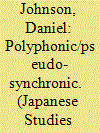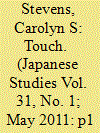| Srl | Item |
| 1 |
ID:
032118


|
|
|
|
|
| Edition |
2nd updated ed.
|
| Publication |
Boulder, Westview Press, 1984.
|
| Description |
xiv, 263p.: figures, tables, photographshbk
|
| Series |
Westview Profiles, Nations of Contamporary Asia
|
| Standard Number |
0865316392
|
|
|
|
|
|
|
|
|
|
|
|
Copies: C:1/I:0,R:0,Q:0
Circulation
| Accession# | Call# | Current Location | Status | Policy | Location |
| 025642 | 952.04/BUR 025642 | Main | On Shelf | General | |
|
|
|
|
| 2 |
ID:
139971


|
|
|
|
|
| Publication |
New York, Praeger Publishers, 1970.
|
| Description |
xv, 256p.hbk
|
| Series |
George School Readings on Developing Lands
|
|
|
|
|
|
|
|
|
|
|
|
Copies: C:1/I:0,R:0,Q:0
Circulation
| Accession# | Call# | Current Location | Status | Policy | Location |
| 004326 | 952/DOW 004326 | Main | On Shelf | General | |
|
|
|
|
| 3 |
ID:
124533


|
|
|
|
|
| Publication |
2013.
|
| Summary/Abstract |
Nicovideo is a popular video-sharing site in Japan that incorporates several aspects of social media into its design. Key among these is the projection of user-made comments into the video display by having text scroll across the screen like an animated subtitle-track. The movement of comments across the screen and the 'pseudo-synchronicity' created by the way they are projected produces a feeling of 'live' viewing via a sense of virtual time shared between users. In this article I argue that the feeling of movement and time on the site directs users toward a certain kind of vision that, when considered alongside the modes of counter-transparent communication taken up by its user base through things like orthographic 'mistypes', is part of a shift between denotational and pictorial forms of text production that troubles the distinction between reading and other modes of vision. The article conceptualizes what kind of vision Nicovideo's interface suggests and its relationship to a distinct kind of polyphonic, anonymous communication that intersects with ideas of animation and performance. It is particularly through the intensity of textual representation that I will pursue these questions.
|
|
|
|
|
|
|
|
|
|
|
|
|
|
|
|
| 4 |
ID:
104163


|
|
|
| 5 |
ID:
104164


|
|
|
|
|
| Publication |
2011.
|
| Summary/Abstract |
This essay explores the idea of touch as a means to think about Japanese popular culture in a transnational perspective. In the years since Appadurai coined the idea of 'scapes' of flow, we have witnessed a growing interest in phenomena associated with border crossing. As a counterpoint, I consider several examples of Japanese culture that could be seen as 'transnational flow', but provide different insights if viewed in terms of touch, encounter, and contact. In particular, I consider a Japanese rapper's dismay at the selection of his album cover as one of the worst of 2010, an American reviewer's distaste at a style of Japanese figurine production, and the integration of contemporary art exhibits in a rural island community in Japan. In each case, the moments and spaces of contact point to a way of understanding cultural influence less via the process of crossing borders than in terms of highlighting locations where cultural difference comes into contact. These examples of 'touch' also offer a way of understanding what makes fieldwork and ethnography such a useful analytical perspective for Japanese studies.
|
|
|
|
|
|
|
|
|
|
|
|
|
|
|
|